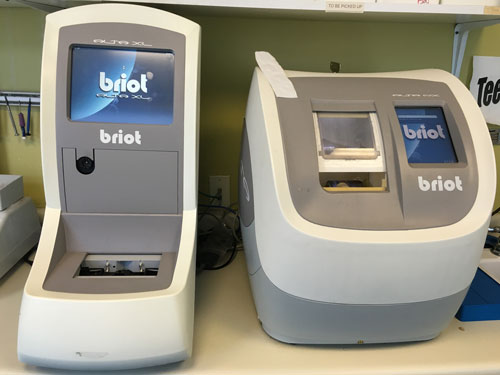Edging ophthalmic lenses has come a long way from hand edging glass lenses on ceramic cutting wheels; the newest revolution in edging systems is the development of automated, multi-axis, computer-controlled routers that can accurately match the bevel of the lens to the frame groove. Some models can drill, edge groove, polish, pin bevel, and even engrave lenses. While the up-front cost of these systems may be expensive, they can save your office money in the long run while increasing revenue.
The major benefits of offering an in-office edging system are to lower your lab bills and decrease your turnaround time to your patients.
Save Money for your Practice
Wholesale labs charge less for an uncut lens than a finished lens, usually to the tune of 15-20% less than a finished lens. This is due to their labor cost, and factors such as maintenance costs of their equipment. If your practice is not very large and you want to start slowly, you might choose a simple all-in-one system and edge the zyl and metal frames with standard bevels, and send more complex drilled and grooved jobs to your lab. Conversely, if you have a large practice, or several locations, you may consider equipment that could edge any job in-house including high-wrap, high astigmatism, or complex lined occupational lenses. Whatever your needs, there is a machine that is right for your practice.
In our office we use a Briot Alta XL, but I have used equipment manufactured by Topcon and Santinelli as well. The beauty of this equipment is the ability to set up the lens to edge and simply walk away while it does the work. This allows me to perform other tasks (such as inspecting jobs or helping patients) while the edger cuts the lens. The ability for opticians to multi-task instead of dedicating time to edging a lens saves money on lab bills while increasing productivity.

New Systems are Easy to Use
Many new systems are designed with ease of use for the operator. They have simple display layouts and guide the user through the edging process from start to finish. Some new machines utilize the latest in auto-refraction technology to align lenses and automate blocking to prevent human error. While no machine is perfect and will require some human input, modern equipment can save opticians or lab technician’s time to perform other tasks such as preparing the next job or inspecting edged lenses for accuracy. These machines can actually increase staff efficiency in your office.

Increased Patient Satisfaction Through Faster Turnaround
An in-office edger allows your office to provide services that many other offices cannot, such as same day service. Your office may choose to keep an assortment of stock lenses at the ready to edge on-site. This allows you to edge lenses for someone who broke their glasses and needs a replacement pair quickly. The fast turnaround you can provide may save someone’s vacation additionally offering same-day service may even close a sale for someone unsure if they’re ready to buy. Even if your office does not stock lenses in-house, uncut lenses are delivered quickly from wholesale labs. Most wholesale labs are working on a huge volume of work, and bottlenecks in one area could delay the work on your more simple order. By finishing the work yourself, you can usually turn around a product faster than if the work is outsourced.
Having an in-house tracing system, even without an edger, can be a huge benefit to patients in terms of convenience. If a patient wishes to re-lens an existing frame, they may not be able to give up their eyewear to be sent to a lab. Having the ability to trace a frame and transmit the shape parameters to a lab allows for a finished lens to be ordered easily. Modern edgers have the ability to store frame data so you can order uncut lenses and finish them in-house for the patient. This allows you to prepare a lens for a patient while they keep their frame and reduces your cost of purchase by ordering an uncut lens. This service to the patient can close a sale to update a prescription when a patient cannot part with their frame.
There are many things to consider when deciding to purchase and operate your own in-office edging system. If you are interested in lowering your lab bills and providing faster and more convenient service to your patients there is an edging system that will fit the needs of your office.
 |
Alex Bennett, ABOM. Alex graduated from Colorado State University in 2007 with a degree in Natural Resources Management. He has been an optician since 2008 and currently works in the Denver metro area. Alex is also a contributing blogger for DailyOptician.com and is completing prerequisite courses in order to qualify for optometry school. In his free time, he enjoys running, rock climbing and traveling.










